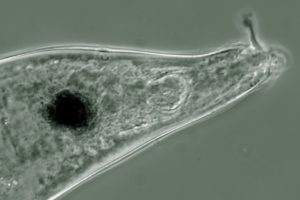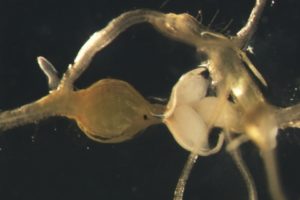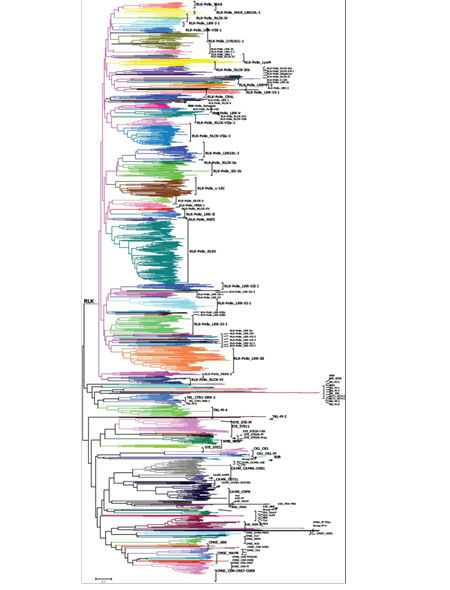Hewezi Laboratory | Lab Members | Projects | Publications | Lab News
Functional characterization of cyst and root-knot nematode effector genes
Plant-parasitic nematodes inject an array of effector proteins into host roots to promote the parasitic interaction. These effectors are expressed specifically in the nematode’s esophageal gland cells. While it now appears that these effectors contribute to disease, the underlying mechanisms remain largely unknown. We are interested in elucidating the molecular mechanism through which these effectors suppress plant defense responses and modulate other cellular processes and molecular functions in order to initiate and maintain functional feeding sites.

In situ hybridization showing the localization of a nematode effector in the nematode dorsal gland cell.

Overexpression of a nematode effector in Arabidopsis enhanced plant susceptibility to beet cyst nematode.

In planta interaction between a nematode effector and a plant protein in the nuclear bodies
Functional characterization of microRNA genes
miRNAs are small non-coding molecules that post-transcriptionally regulates the expression of their target containing complementary binding sites. Recent findings in my lab indicate that miRNAs function as master regulators modulating the expression of thousands of genes differentially expressed in the nematode feeding sites. We are investigating the regulatory events controlled by miRNAs and their targets that allow re-differentiation of mature parasitized root cells into specialized feeding cells. Because many of these miRNAs are involved in a variety of developmental processes, we are also interested in elucidating the mechanisms employed by these regulatory factors to synchronize developmental processes and defense responses during nematode infection.

Expression of an Arabidopsis miRNA gene in the syncytium.

Phenotypes of Arabidopsis plants overexpressing a miRNA gene (right) and wild type (left).
Epigenetic control of plant-nematode interaction
Recent discoveries from my lab indicate that epigenetic modifications, biochemical modifications of DNA and associated proteins, play key roles in shaping the compatibility of the interactions between host plants and plant-parasitic nematodes. My team is currently investigating genome-wide epigenetic modifications that are associated with infection by cyst and root-knot nematodes in a number of model and crop plant species. Simultaneous profiling of genome-wide DNA methylation patterns and histone modifications combined with mRNA and small RNA transcriptomes will lead to the discovery of new mechanisms of nematode parasitism that link epigenetic modifications to re-programing and differentiation of infected root cells into permanent multinucleated feeding structure.

Mapping differentially methylated regions and overlapping genes, identified in response to infection to soybean cyst nematode, to the 20 soybean chromosomes. (Rambani et al., 2015 Plant Psychology 168:1364-1377)
Functional characterization of soybean kinome

Classification of soybean protein kinase subfamilies. (Liu et.al., 2015; J Exp Bot 66: 1919-1934)
The protein kinase gene family is one of the largest and highly conserved gene families in eukaryotes and plays key regulatory roles in nearly all cellular processes. My lab has identified the entire soybean protein kinase repertoire, which included 2,166 protein kinase gene candidates, representing about 5% of all soybean protein-coding genes. Gene expression analysis suggested regulatory functions of this large gene family over numerous developmental and physiological processes. We are studying the functional roles of various kinase subfamilies in mediating plant responses to stress factors and developmental stimuli using an integrated approach of molecular, biochemical, and cell biology techniques.
Elucidating the mode of action of phytohormone signaling in plant × nematode interactions
In accordance with the central roles of phytohormones in cellular differentiation and organ morphogenesis, a growing body of experimental evidence indicates that plant-parasitic cyst and root-knot nematodes interfere with hormonal biosynthesis pathways and their signal transduction cascades to drive the infected root cells into becoming specialized new feeding cells. Recently, we determined the expression patterns of 22 auxin response factors (ARFs) in the syncytia induced by the beet cyst nematode in Arabidopsis roots. The expression patterns suggested roles of ARFs in syncytium initiation and establishing its maximum size by incorporating neighboring cells with the initial feeding cells, as well as in maintaining the functional phenotype of fully-developed syncytium. Also, our results indicate that formation of syncytium and giant-cell is mediated by modulation of cytokinin and ethylene signaling. We are interested in elucidating the induced hormonal crosstalk that modulates plant-nematode interactions.

Expression of ARFs in the developing syncytium (left) and neighboring cells (right). N = nematode, S = syncytium.

Model illustrating the spatio-temporal expression patterns of ARFs during syncytium initiation, formation and maintenance stages. (Hewezi et al., 2014; Mol Plant Pathol 15: 730-736)